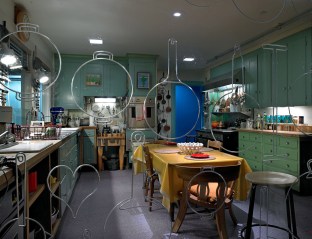“Tell me what you eat, and I will tell you what you are,” observed Jean Anthelme Brillat-Savarin, the greatest of French gourmands. Brillat-Savarin knew a thing or two about food identity: he wrote his masterpiece in 1825, at the absolute peak of French food culture, a belle epoque of foie gras, Normandy butter and a Bresse chicken in every pot. So who are the American people, judged by what we eat?
(MORE: What Happened to the American Middle-Class Meal?)
That’s a question worth asking as many families prepare to consume more home-cooked dishes on Thanksgiving than they do during the entire rest of the year. Convenience has become our national staple, and it’s one of the big themes addressed by a new exhibit at the Smithsonian’s National Museum of American History, called “Food: Transforming the American Table 1950–2000.” The exhibit, which opened Nov. 20, is a lot of fun, especially for those of us with a nostalgic bent; its pupu platters, Veg-O-Matics and Swanson TV-dinner trays stir old memories, even if what we’re remembering are the old TV commercials about these products rather than using the products themselves. Speaking of TV, the exhibit includes Julia Child’s actual kitchen, complete with her oven, all her tools and even her cabinets and counters. The disjunction between the Veg-O-Matic and Child’s emphasis on classic cooking techniques says a lot about who we are. It says that America, for good or bad, has been going its own way for a long, long time, and that way leads to the lab, the factory, the store and the couch, where consumers watch people like Julia Child rather than follow her advice in the kitchen.
(MORE: Top 10 Things You Didn’t Know About Thanksgiving)

Julia Child’s Kitchen from the Smithsonian exhibition
Child is, of course, the patron saint of a certain kind of American foodie. The woman who taught America to cook French food, she is regarded, eight years after her death, as the epitome of how Americans ought to eat but don’t. When Julie Powell, on her Julie/Julia blog, chronicled her attempt to cook her way through Mastering the Art of French Cooking, it was more in the nature of a stunt, a David Blaine–style endurance test. Nobody cooks like Julia Child today; that may be the reason so many people look up to her. Galantine a chicken lately? How about peel 24 pearl onions for some boeuf bourguignon? If you have done so, congratulations; you are a true child of Child. For the other 99.5% of the people reading this, I’m guessing you are far more familiar with the following items, all taken from the New and Improved section of the Smithsonian exhibit: a can of frozen concentrated orange juice, a Slurpee superhero cup, a George Foreman grill, a JCPenney microwave, a Teflon Bundt pan. I have never cooked a Bundt cake in my life, but I remember seeing that pan in my grandmother’s kitchen — and everything else on that list too. And those things weren’t signs of corruption or laziness or TV brainwashing; they were fun, practical tools that, Bundt pan aside, we used every day. They were our true foodways.
(MORE: Burger King Home Delivery: The Last Nail in the Coffin of Real Food)
(MORE: Does Jewish Food Have A Future?)
Why did Slurpees and microwave ovens become part of the way most Americans eat while brown rice and bean sprouters did not? The answer is simple to anyone who has sucked down a Slurpee or two: they’re awesome. Microwaves are supremely convenient, a quick way to cook Lean Cuisines (which, like so much else we eat, would have appalled Julia Child), whereas almost nobody likes brown rice or home-baked brown bread — certainly not enough to cook them regularly. There are, of course, any number of fads that came and went over the years: fondue pots, Tang, tiki trays. Not every new toy or trick can become universal. Our kitchens, and stomachs, are only so big. But cheap, crappy, delicious, highly engineered and ultra-designed food is in our DNA, and that isn’t going to change. A sequel to the Smithsonian exhibit, curated by the Lunar Institute in 2062, won’t consist of wood ovens, organic gardens and heritage vegetables. What it will include is anybody’s guess. But if who we are really is expressed by how we eat, something tells me it will not come from Julia’s kitchen — or anybody else’s.

